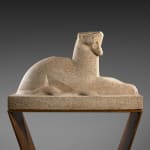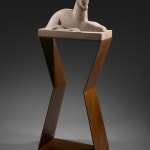


Joseph Csaky
Length: 25.4 in. (64.7 cm.)
Depth: 11.7 in. (29.8 cm.)
Height with pedestal: 61.8 in. (157 cm.)
Further images
In 1924 Joseph Csaky’s cubism was becoming progressively tamer and more mature. Less radical and abstract, his style was hearing towards a “return to order” along with other major Modernists. No longer under contractual obligations to sell all his work exclusively to Léonce Rosenberg (which did not stop the dealer from buying Csaky’s pieces until 1936) the artist finally felt free to experiment with his art. He used the term “figurative cubism” to describe his style, inspired by archaic Greece and ancient Egypt.
By 1928 Csaky's career was at its peak; his work was exhibited in the best galleries and art fairs in Europe and in the United States. A major art patron of the day, fashion designer Jacques Doucet commissioned the artist to execute the banister at his "Studio" on 33 rue Saint-James in Neuilly near Paris - a palace of modernity. The two most likely met at the Rosenberg Gallery (Galerie de l'Effort Moderne) around 1923. Falling in love with Csaky's work, the fashion designer bought several pieces, including the famous "Head" in rock crystal and stylized "Head of a Lioness" in granite. The Rue Saint-James stairwell was the focal point of the Studio, housing not only Picasso's "Les Demoiselles d'Avignon" but also Brancusi's "Danaïde," which rested on a stylized column executed by Csaky, who was a friend of the artist. The banister he created was wrought steel, decorated with stylized figures of parrots and peacocks. It was also adorned with “opaline” plaques engraved with panthers, whose characteristics are very close to that of the present sculpture.
"Reclined Panther" is arguably one of Csaky's most beautiful works. The feline’s majestic pose and unwavering gaze evoke the Middle Kingdom Egyptian statuary of goddess Sekhmet in black granite. Influences from Assyrian bas-reliefs of the “Lion Hunt” (British Museum) in Nineveh and Khorsabad as well as Hellenistic sculpture of “Lion of Knidos” (British Museum) dating from 2nd century BC are all present in this work. Csaky never hid his passion for antiquity, and managed to masterfully adopt it to his own time. Through the prism of Cubism, the artist modernized his work, stripping it of all unnecessary details. His exquisite simplicity, evoking Brancusi’s work, allows light to penetrate the stone, revealing all of its splendor.
In 1928, Csaky participated in the Salon des Tuileries, and it is likely that he met the buyer of the “Reclining Panther” there. Around 1956, the artist befriended a young couple from the Amiens region. Passionate about his work, and having bought several pieces dated after WWII, the Vanbremeerschs wished to buy a work from the 1920s. Unfortunately, the artist only possessed a limited number of early works, which were becoming increasingly rare in the art market. The sculptor ended up convincing the son of the first owner of the sculpture (Mr. Jacques Kélékian) to sell if for a very considerable amount to the young couple, as can be seen from surviving correspondence between him and Mrs. Vanbremeersch.
A sculptural masterpiece from the first part of the 20th century by a major artist, this piece is an extremely rare find. Sadly, a significant part of Joseph Csaky’s oeuvre was destroyed or lost and the artist’s life later ended in poverty. Therefore, the rarity of this gorgeous work can not be overstated.
Provenance
Jacques Kélékian collection, thence by descent to his son.
Mr. and Mrs. Vanbremeersch, acquired from the above on advice of Joseph Csaky in August 1960.
Exhibitions
Musée d'art moderne, Csaky, Sculptures-Dessins, Troyes, France 1986, N°26.
Literature
Waldemar Georges, Arts éditeur, Paris, 1930, p.34.American Philosophical Society, Philadelphia, 1998, fig.58, p.91.
Félix Marcilhac, Joseph Csaky, du cubisme historique à la figuration réaliste, catalogue raisonné des sculptures, Paris, 2007, p.347, no. 1928-FM.140/a.
Csaky photographic archives (AC.82) image by Marc Vaux.


